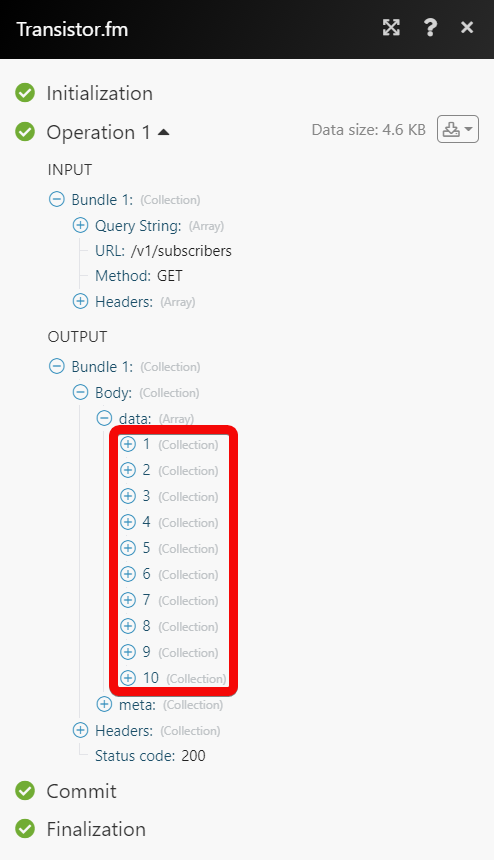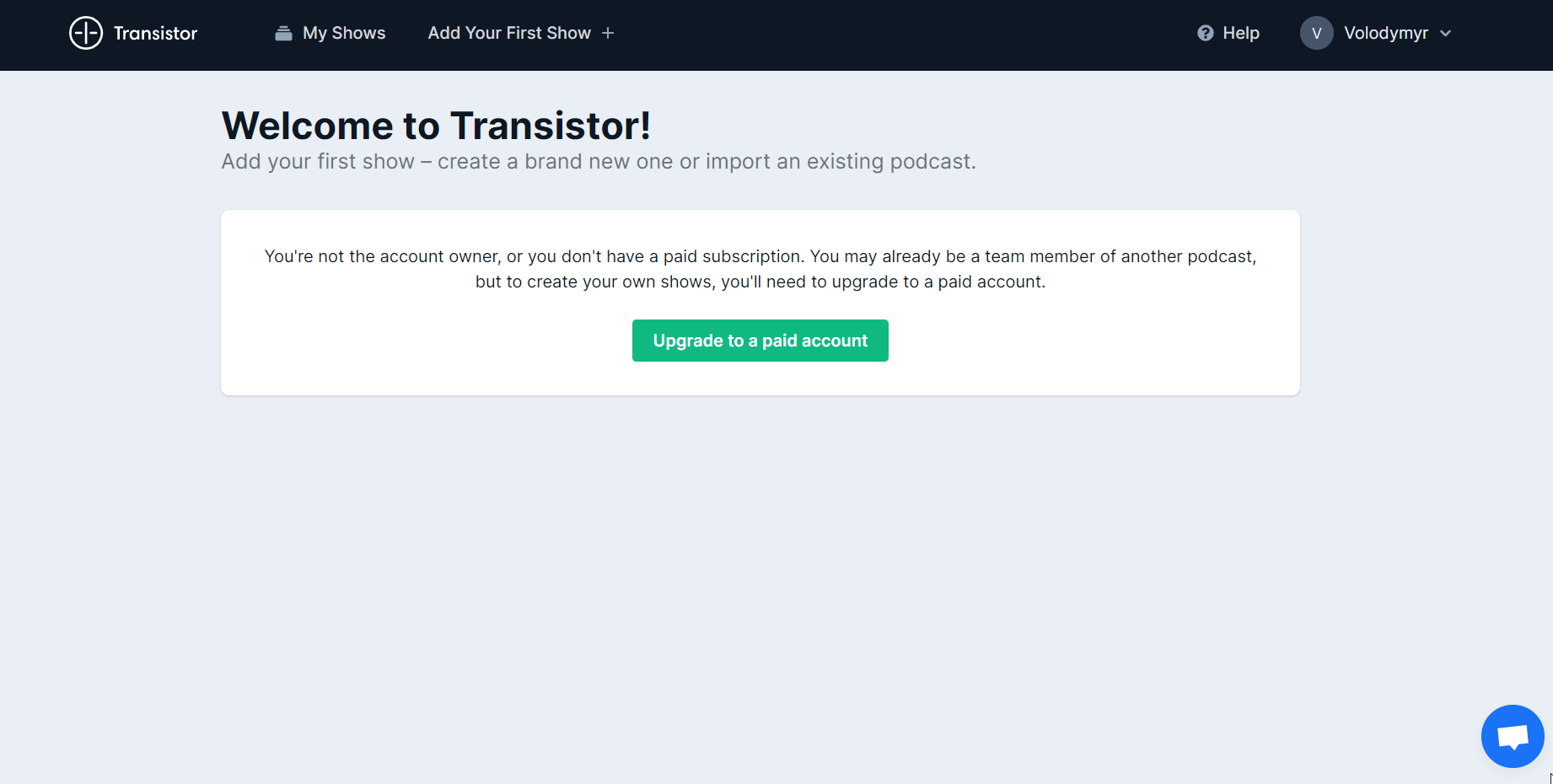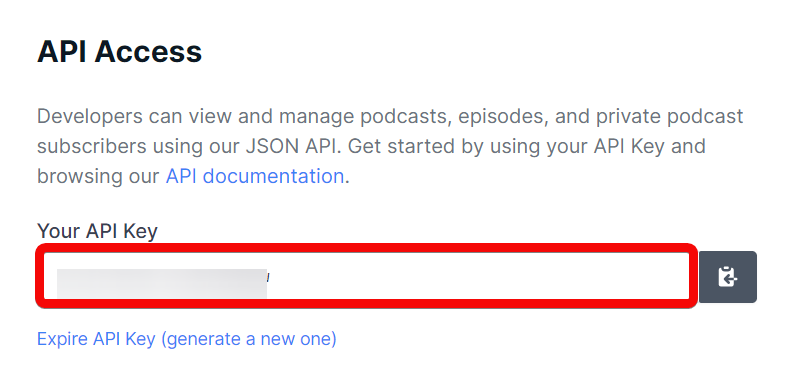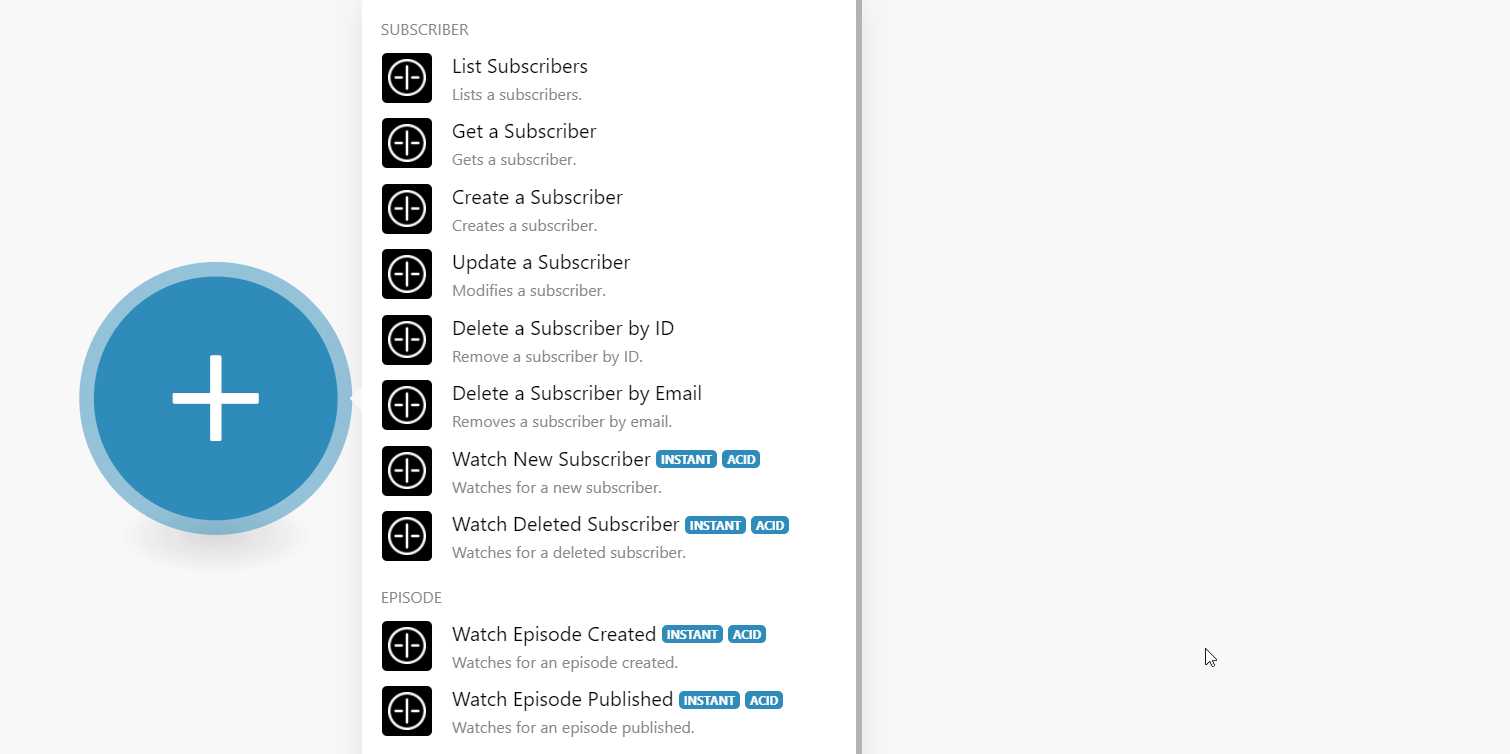| Active with remarks |
|---|
| This application needs additional settings. Please follow the documentation below to create your own connectionUnique, active service acces point to a network. There are different types of connections (API key, Oauth…). More. |
The Transistor.fm modulesThe module is an application or tool within the Boost.space system. The entire system is built on this concept of modularity. (module - Contacts) More allow you to monitor, create, update, send, retrieve, list, and delete the subscribers, and episodes in your Transistor.fm account.
Prerequisites
-
A Transistor.fm account – create an account at the transistor.fm/.
![[Note]](https://docs.boost.space/wp-content/themes/bsdocs/docs-parser/HTML/css/image/note.png) |
Note |
|---|---|
|
The moduleThe module is an application or tool within the Boost.space system. The entire system is built on this concept of modularity. (module - Contacts) More dialog fields that are displayed in bold (in the Boost.spaceCentralization and synchronization platform, where you can organize and manage your data. More IntegratorPart of the Boost.space system, where you can create your connections and automate your processes. More scenarioA specific connection between applications in which data can be transferred. Two types of scenarios: active/inactive. More, not in this documentation article) are mandatory! |
To connect your Transistor.fm account to Boost.space Integrator you need to obtain the API Key from your Transistor.fm account and insert it in the Create a connection dialog in the Boost.space Integrator module.
-
Log in to your Transistor.fm account.
-
Click Your Profile Icon > Your Account.
-
Copy the API key to your clipboard.
-
Go to Boost.space Integrator and open the Transistor.fm module’s Create a connection dialog.
-
In the Connection name field, enter a name for the connection.
-
In the API Key field, enter the API key copied in step 3, and click Continue.
The connection has been established.
Lists subscribers.
|
Connection |
|
|
Show ID |
Select or map the Show ID whose subscribers you want to list. |
|
Query |
Enter (map) a name or phrase to list the subscribers that match the specified query. |
|
Limit |
Set the maximum number of subscribers Boost.space Integrator should return during one execution cycleA cycle is the operation and commit/rollback phases of scenario execution. A scenario may have one or more cycles (one is the default).. |
Gets a subscriber.
|
Connection |
|
|
Show ID |
Select or map the Show ID whose subscriber details you want to retrieve. |
|
Subscriber ID |
Select or map the Subscriber ID whose details you want to retreive. |
Creates a subscriber.
|
Connection |
|
|
Email Address |
Enter (map) the email address of the subscriber. |
|
Show ID |
Select or map the Show ID for which you want to create the subscriber. |
Modifies a subscriber.
|
Connection |
|
|
Show ID |
Select or map the Show ID whose subscriber details you want to update. |
|
Subscriber ID |
Select or map the Subscriber ID whose details you want to update. |
|
New Subscriber Email |
Enter (map) the subscriber’s email address. |
Remove a subscriber by ID.
|
Connection |
|
|
Show ID |
Select or map the Show ID whose subscriber details you want to delete. |
|
Subscriber ID |
Select or map the Subscriber ID you want to delete. |
Removes a subscriber by email.
|
Connection |
|
|
Email Address |
Enter (map) the subscriber’s email address you want to delete. |
|
Show ID |
Select or map the Show ID to which the subscriber belongs. |
Note: You do not have to add the webhooksA webhook is a way for an app to send real-time information to a specific URL in response to certain events or triggers. in the Transistor.fm as it is automatically done for you once you add and save an instant triggerEvery scenario has a trigger, an event that starts your scenario. A scenario must have a trigger. There can only be one trigger for each scenario. When you create a new scenario, the first module you choose is your trigger for that scenario. Create a trigger by clicking on the empty module of a newly created scenario or moving the... module to your scenario.
Watches for a new subscriber.
|
WebhookA webhook is a way for an app to send real-time information to a specific URL in response to certain events or triggers. Name |
Enter a name for the webhook. |
|
Connection |
|
|
Show ID |
Select or map the Show ID whose new subscribers you want to watch. |
Watches for a deleted subscriber.
|
Webhook Name |
Enter a name for the webhook. |
|
Connection |
|
|
Show ID |
Select or map the Show ID whose deleted subscribers you want to watch. |
Note: You do not have to add the webhooks in the Transistor.fm as it is automatically done for you once you add and save an instant trigger module to your scenario.
Watches for an episode created.
|
Webhook Name |
Enter a name for the webhook. |
|
Connection |
|
|
Show ID |
Select or map the Show ID whose episodes you want to watch. |
Watches for an episode published.
|
Webhook Name |
Enter a name for the webhook. |
|
Connection |
|
|
Show ID |
Select or map the Show ID whose published episodes you want to watch. |
Performs an arbitrary authorized API call.
|
Connection |
||||
|
URL |
Enter a path relative to
|
|||
|
Method |
Select the HTTP method you want to use: GET to retrieve information for an entry. POST to create a new entry. PUT to update/replace an existing entry. PATCH to make a partial entry update. DELETE to delete an entry. |
|||
|
Headers |
Enter the desired request headers. You don’t have to add authorization headers; we already did that for you. |
|||
|
Query String |
Enter the request query string. |
|||
|
Body |
Enter the body content for your API call. |
The following API call returns all the subscribers from your Transistor.fm account:
URL:
/v1/subscribers
Method:
GET
Query String: Key: show_id Value: 23169

Matches of the search can be found in the module’s Output under BundleA bundle is a chunk of data and the basic unit for use with modules. A bundle consists of items, similar to how a bag may contain separate, individual items. More > Body > data.
In our example, 10 subscribers were returned:




